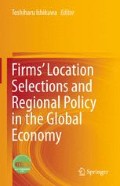Abstract
This chapter examines agglomeration economies and how they affect the location of firms. First, the relevant literature on agglomeration economies is introduced. Second, we investigate each component of these economies in terms of scale, scope, and complexity (spatially constrained internal and external economies). Internal economies are internal to the firm and external to the industry, while external economies are external to the firm and internal to the industry, with some exceptions. We also discuss negative elements, such as urbanization diseconomies. Third, the roles played by agglomeration economies in sustainable regional development are explored. We reveal that the enhancement of economic infrastructure elements is immediately beneficial to producers. A simple model framework is introduced to analyse how location advantages are related to agglomeration economies by comparing two physically separate locations. The impact on regional development of changes in agglomeration economies is then divided into two parts: economic elements and social infrastructure elements. Economic infrastructure elements that are relevant to industrial location are conventionally understood to be the trade-off between agglomeration economies and transportation costs. Other dimensions include social infrastructure elements, which are immediately beneficial to households and may affect the level of regional attractiveness for local residents. The policy implications for sustainable regional development need a well-balanced combination of both types of elements. Finally, we address further avenues of research on agglomeration economies, such as the importance of internal economies through the application of production and cost functions.
Part of a preliminary version of this article was presented at the International Symposium of Firm’s Location Selections and Regional Policy in Global Economy in June 2014 at Chuo University Graduate School, Tokyo, and was partially supported by the Japan Society for the Promotion of Science (JSPS) KAKENHI, Grant Number 25780179.
Access this chapter
Tax calculation will be finalised at checkout
Purchases are for personal use only
References
Brakman, S., Garrestsen, H., & van Marrewijk, C. (2009). The new introduction to geographical economics. Cambridge: Cambridge University Press.
Fratesi, U., & Senn, L. (2009). Growth and innovation of competitive regions. Heidelberg: Springer.
Fujita, M., & Thisse, J.-F. (2002). Economics of agglomeration – Cities, industrial location, and regional growth. Cambridge, UK: Cambridge University Press.
Fujita, M., Krugman, P., & Venables, A. J. (1999). The spatial economy: Cities, regions, and international trade. Cambridge, MA: MIT Press.
Glaeser, E. L., Kolko, J., & Saiz, A. (2001). Consumer city. Journal of Economic Geography, 1, 27–50.
Hoover, E. M. (1937). Location theory and the shoe and leather industries. Cambridge, MA: Harvard University Press.
Hummels, D., Ishii, J., & Yi, K.-M. (1995). The nature and growth of vertical specialization in world trade. Journal of International Economics, 54(1), 75–96.
Isard, W. (1956). Location and space-economy. Cambridge, MA: MIT Press.
Jones, R. W., & Kierzkowski, H. (2005). International fragmentation and the new economic geography. The North American Journal of Economics and Finance, 16(1), 1–10.
Marshall, A. (1892). Economics of industry (3rd ed.). London: Macmillan and Co. Limited.
Meade, J. E. (1952). External economies and diseconomies in a competitive situation. The Economic Journal, 62(245), 54–67.
Nakamura, D. (2013). A note on spatial policy for a competitive regional system. Journal of Urban Management, 2(1), 103–112.
Nakamura, D. (2014). Social participation and social capital with equity and efficiency: An approach from central-place theory. Applied Geography, 49, 54–57.
Ohlin, B. (1967). Interregional and international trade. Cambridge: Harvard University Press.
Parr, J. B. (2002a). Agglomeration economies: Ambiguities and confusions. Environment and Planning, 34(4), 717–731.
Parr, J. B. (2002b). Missing elements in the analysis of agglomeration economies. International Regional Science Review, 25(2), 151–168.
Scitovsky, T. (1954). Two concepts of external economies. Journal of Political Economy, 62(2), 143–151.
Silva, C. E. L., & Hewings, G. J. D. (2010). Locational and managerial decisions as interdependent choices in the headquarter-manufacturing plant relationship: A theoretical approach. Annals of Regional Science, 48(3), 703–717.
Stigler, G. J. (1951). The division of labor is limited by the extent of the market. Journal of Political Economy, 59(3), 185–193.
van Leeuwen, E. S. (2010). Urban-rural interactions: Towns as focus points in rural development. Heidelberg: Springer.
Weber, A. (1909 [1928]). Über den Standort der Industrien (C. J. Friedrich, as Alfred Weber’s Theory of the Location of Industries, Trans.) Chicago: University of Chicago Press, 1928.
Author information
Authors and Affiliations
Corresponding author
Editor information
Editors and Affiliations
Rights and permissions
Copyright information
© 2015 Springer Japan
About this chapter
Cite this chapter
Nakamura, D. (2015). Firm Location and Agglomeration Economies. In: Ishikawa, T. (eds) Firms’ Location Selections and Regional Policy in the Global Economy. Springer, Tokyo. https://doi.org/10.1007/978-4-431-55366-3_1
Download citation
DOI: https://doi.org/10.1007/978-4-431-55366-3_1
Publisher Name: Springer, Tokyo
Print ISBN: 978-4-431-55365-6
Online ISBN: 978-4-431-55366-3
eBook Packages: Business and EconomicsEconomics and Finance (R0)

